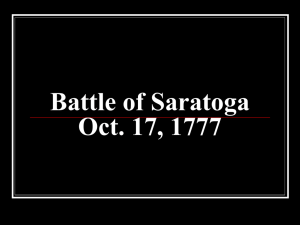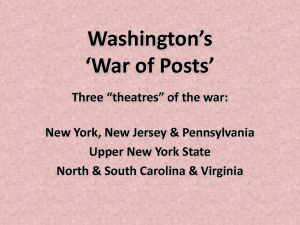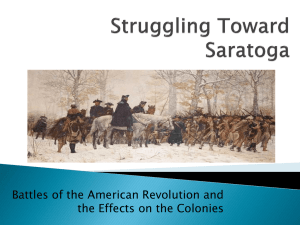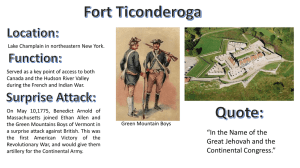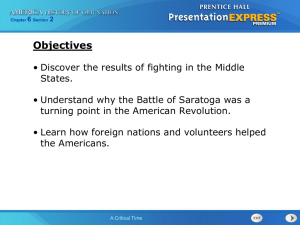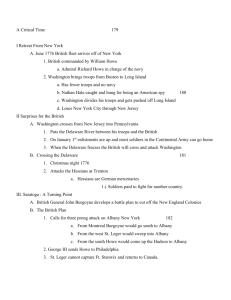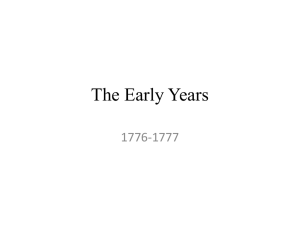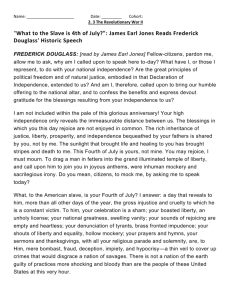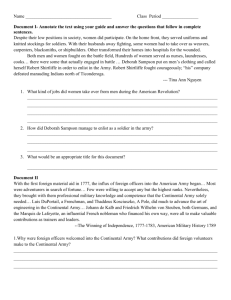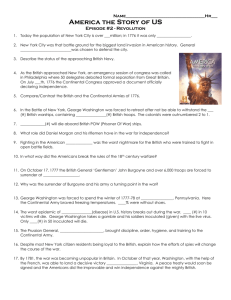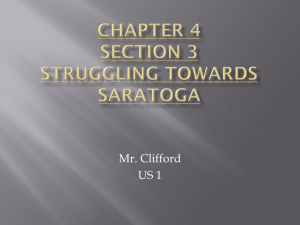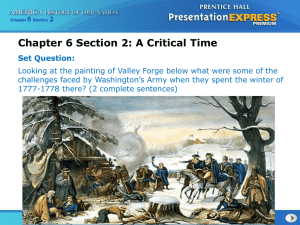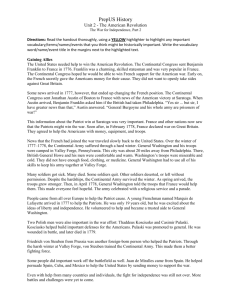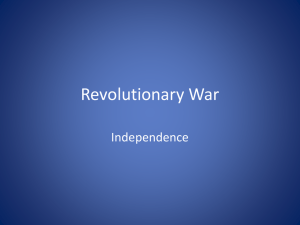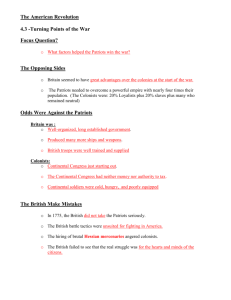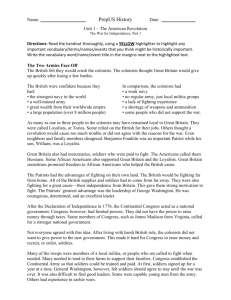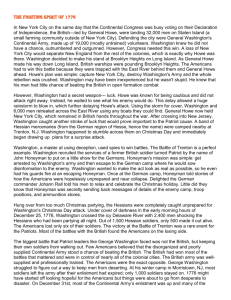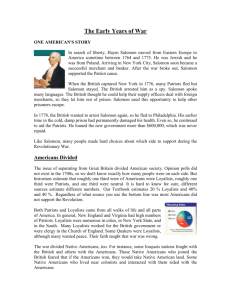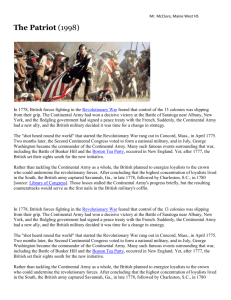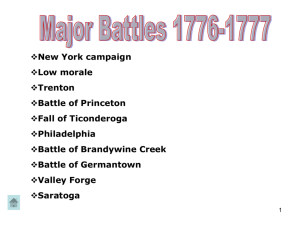section 1. objectives - Lyndhurst School District
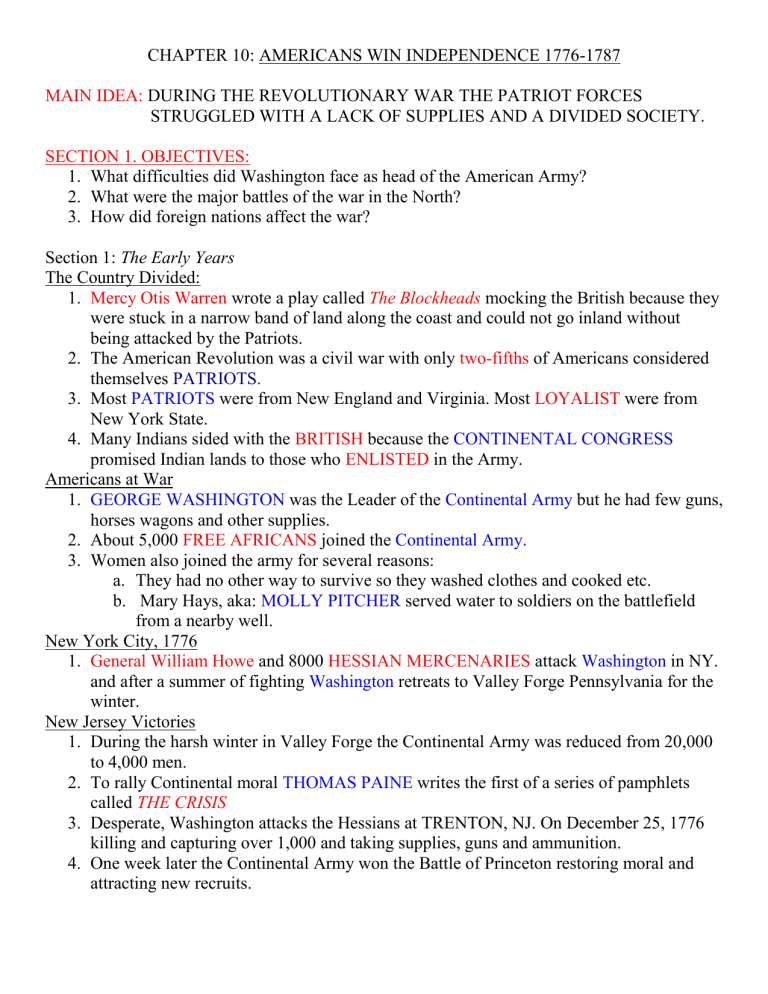
CHAPTER 10: AMERICANS WIN INDEPENDENCE 1776-1787
MAIN IDEA: DURING THE REVOLUTIONARY WAR THE PATRIOT FORCES
STRUGGLED WITH A LACK OF SUPPLIES AND A DIVIDED SOCIETY.
SECTION 1. OBJECTIVES:
1.
What difficulties did Washington face as head of the American Army?
2.
What were the major battles of the war in the North?
3.
How did foreign nations affect the war?
Section 1: The Early Years
The Country Divided:
1.
Mercy Otis Warren wrote a play called The Blockheads mocking the British because they were stuck in a narrow band of land along the coast and could not go inland without being attacked by the Patriots.
2.
The American Revolution was a civil war with only two-fifths of Americans considered themselves PATRIOTS.
3.
Most PATRIOTS were from New England and Virginia. Most LOYALIST were from
New York State.
4.
Many Indians sided with the BRITISH because the CONTINENTAL CONGRESS promised Indian lands to those who ENLISTED in the Army.
Americans at War
1.
GEORGE WASHINGTON was the Leader of the Continental Army but he had few guns, horses wagons and other supplies.
2.
About 5,000 FREE AFRICANS joined the Continental Army.
3.
Women also joined the army for several reasons: a.
They had no other way to survive so they washed clothes and cooked etc. b.
Mary Hays, aka: MOLLY PITCHER served water to soldiers on the battlefield from a nearby well.
New York City, 1776
1.
General William Howe and 8000 HESSIAN MERCENARIES attack Washington in NY. and after a summer of fighting Washington retreats to Valley Forge Pennsylvania for the winter.
New Jersey Victories
1.
During the harsh winter in Valley Forge the Continental Army was reduced from 20,000 to 4,000 men.
2.
To rally Continental moral THOMAS PAINE writes the first of a series of pamphlets called THE CRISIS
3.
Desperate, Washington attacks the Hessians at TRENTON, NJ. On December 25, 1776 killing and capturing over 1,000 and taking supplies, guns and ammunition.
4.
One week later the Continental Army won the Battle of Princeton restoring moral and attracting new recruits.
Philadelphia, 1777
1.
General Howe captures the American Capital of Philadelphia and the Continental
Congress moves to York, Penn.
The British Strategy:
1.
The British wanted to seize the Hudson Valley and cut the Colonies in half.
2.
The plan was to have three British armies meet in Albany, NY to cut off New England. a.
General John “Gentleman Johnny” Burgoyne would head south from Canada. b.
General Barry St. Leger would move east from Lake Ontario. c.
General William Howe would move north from NY City.
3.
This did not work for several reasons. a.
“Gentleman Johnny” Burgoyne traveled slow and threw parties after each battle. b.
Howe sent a note to Burgoyne saying he would not RENDEZVOUS him in Albany because he was
FOLLOWING WASHINGTON’S ARMY wrecking the plan .
c.
General Leger was TRICKED by Continental General BENEDICT ARNOLD and his Indians when they FALSELY spread rumors that Arnold had a huge army causing General Leger to retreat so fast they left behind supplies, cannons and tents.
Saratoga-A Turning Point
1.
Continental General Horatio Gates waited at Freeman’s Farm near Saratoga NY. For
Burgoyne.
2.
GATES and his men were dug in earthworks put up by Thaddeus Kosciuszko a Polish engineer helping the PATRIOTS.
3.
After two battles at Freeman’s Farm, Horatio Gates and Benedict Arnold defeated
Burgoyne and drove him back to Saratoga, NY.
4.
General “Gentleman Johnny” Burgoyne eventually surrendered at
SARATOGA loosing
6,000 men.
*** IMPORTANT: SARATOGA was a turning point in the war because FRANCE recognized
American Independence and formed an alliance in 1778 also convincing Spain to join the war on the American’s side.
Help From Abroad:
1.
France and Spain gave the Americans much needed money and supplies and troops.
2.
In 1779-17780 The Spanish Governor of Louisiana ,
General Bernardo de Gálvez captured the British strongholds of Natchez and Baton Rouge and the Mobile, and in
1781 Pensacola in Florida, this protected America from British invasions from the southwest.
